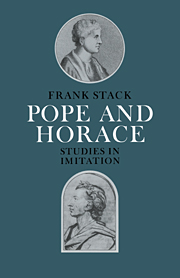Book contents
- Frontmatter
- Contents
- Acknowledgements
- List of abbreviations
- Preface
- PART I INTRODUCTIONS
- PART II THREE HORATIAN SATIRES (1733–4)
- PART III MATURE HORACE (1736–7)
- PART IV THE TIME OF TENSION (1738)
- 9 Idealism and scepticism: The Imitation of Epistle I.vi.
- 10 Fables of the self: The Imitations of Satire II.vi. and Epistle I.vii.
- 11 The Stoic self: The Imitation of Epistle I.i.
- Epilogue
- Appendix: Imitations of Horace published 1730–40
- Notes
- Bibliography
- Index
11 - The Stoic self: The Imitation of Epistle I.i.
Published online by Cambridge University Press: 08 January 2010
- Frontmatter
- Contents
- Acknowledgements
- List of abbreviations
- Preface
- PART I INTRODUCTIONS
- PART II THREE HORATIAN SATIRES (1733–4)
- PART III MATURE HORACE (1736–7)
- PART IV THE TIME OF TENSION (1738)
- 9 Idealism and scepticism: The Imitation of Epistle I.vi.
- 10 Fables of the self: The Imitations of Satire II.vi. and Epistle I.vii.
- 11 The Stoic self: The Imitation of Epistle I.i.
- Epilogue
- Appendix: Imitations of Horace published 1730–40
- Notes
- Bibliography
- Index
Summary
My poetical affairs drawing toward a fair period, I hope the day will shortly come when I may honestly say
Nunc versus et caetera ludicra pono,
Quid verum atque decens, curo et rogo et omnis in hoc sum.
That caetera ludicra is very comprehensive: it includes visiting, masquerading, play-hanting [sic], sauntering, and indeed almost includes all that the world calls living.
Pope to Caryll, 4 February 1718Pope'sImitation of Epistle I.i., addressed to Bolingbroke, is an extremely paradoxical poem. From one point of view this is a very public poem, a vigorous and daring attack on the city and the court, written at a time of mounting political tension, and boldly addressed to Bolingbroke as the government's long-standing enemy. In March 1738, when the poem was published, Bolingbroke was in retirement in France, but due back in England imminently. There were even suggestions that at this critical juncture, he should again be the leader of the Tories. To address a poem to Bolingbroke at this time was indeed ‘a calculated affront’ (Mack, 1969, p. 168), and taken as such by the government newspapers (TE, iv, p.xxxviii–ix). But from another point of view this is a very personal work, a poem about retirement in which Pope speaks to Bolingbroke as his close friend about his own inner spiritual yearnings, weaknesses, and failures.
Criticism of this Imitation has tended to emphasize one side or other of this paradox, whereas what really seems important is the paradox itself, and confirmation for this comes from the fact that the whole Horatian epistle is built around just these tensions.
- Type
- Chapter
- Information
- Pope and HoraceStudies in Imitation, pp. 245 - 274Publisher: Cambridge University PressPrint publication year: 1985

